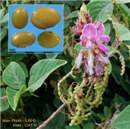Scientific name(s)
Desmodium intortum
Strengths
- Good early and late season vigour
- Shade tolerant
- Combines with both tussock and creeping grasses
Limitations
- Low seedling vigour
- Poor persistence under heavy grazing
- Susceptibility to pests
- Poor tolerance of drought and salinity
Plant description
Plant: A large trailing and scrambling perennial legume with a strong taproot.
Stems: Grooved, hairy and reddish-brown in colour, branching freely, and rooting at the nodes. They are not as heavy as, and less hairy than those of silverleaf desmodium.Leaves: Comprise three dark green leaflets, each commonly about 4cm long and 3cm wide, with reddish-brown flecking on the upper surface.
Flowers: Small (less than 1cm long), deep pink to lilac, borne in groups at the ends of the stems in late May - early June.
Pods: Narrow segmented pods to 5 cm long, each holding 8 - 12 seeds. The segments break up when mature and, being covered with short hooked hairs, will stick to hair or clothing, but not as tenaciously as those of silverleaf desmodium.
Seeds: Flattish, yellow-brown, oval-kidney shaped seeds about 1.5 mm long; about 595,000 seeds per kg.
Pasture type and use
Grown in association with tussock and more open sward-forming grasses in permanent, semi-intensively managed pastures.
Where it grows
Rainfall
Greenleaf requires good moisture, growing best in areas receiving at least 1,200 mm rainfall, with warm season dominance. Late season rainfall is essential for successful seed-set.
Soils
Greenleaf requires good moisture, growing best in areas receiving at least 1,200 mm rainfall, with warm season dominance. Late season rainfall is essential for successful seed-set.
Temperature
Greenleaf is subtropical and grows well into the cool season if moisture is adequate. It is more tolerant of light frosts than creeping vigna, but is "cut" by heavier frost.
Establishment
Companion species
Grasses: Green and Gatton panics, kikuyu, pangola, paspalum, rhodes grass, setaria.
Legumes: Creeping vigna, glycine, greater lotus (e.g. Maku), siratro, white clover
Sowing/planting rates as single species
Not sown as single species.
Sowing/planting rates in mixtures
1 -2 kg/ha
Sowing time
Sowing is best carried out when there is a high probability of follow-up moisture. In frosted areas, 'Greenleaf' should be sown in spring, once the probability of frost is low, to give as long a period as possible for establishment prior to onset of next frosts.
Inoculation
Although seedlings may nodulate with native rhizobia, it is best to inoculate seed with special Desmodium inoculant to ensure the most effective nitrogen fixation.
Fertiliser
It requires at least moderate levels of fertility, and phosphorus, sulphur, and potassium may need to be applied. 'Greenleaf' has a high requirement for molybdenum, and may need up to 300g/ha of molybdenum trioxide at sowing, or 600g/ha sodium molybdate applied in solution post-emergence.
Management
Maintenance fertliser
Soil fertility should be maintained with applications of about 200kg/ha superphosphate every 2 years, and muriate of potash as required, particularly if the 'Greenleaf' is growing with setaria.
Grazing/cutting
Mature plants cannot tolerate constant heavy grazing or frequent heavy defoliation in which the growing points are removed; vigorous, dense stands are reduced to a scattering of small individual plants. Grazing pressure should be adjusted to remove a proportion of leaf but retain growing points. Even under careful grazing management, 'Greenleaf' rarely persists for more than 6 years, except in high rainfall environments.
Seed production
'Greenleaf' flowers late in the season, so seed crops should be grown in a fairly frost-free environment. Mechanical harvest is made difficult by uneven ripening of the seed and the sticky nature of the seed pods which can 'ball-up'. Stands are cut and windrowed and left to dry for 2 weeks before being threshed by a pick-up harvester using the highest possible drum speed and close concave settings. Yields of 80 - 100 kg/ha seed are common.
Ability to spread
Plants spread vegetatively, by rooting down along the trailing stems. Spread from seed is limited because it mostly grows in areas where there is a high level of competition for the small, weak seedlings.
Weed potential
While it has some potential to spread into ungrazed, moist, shaded areas, it is not seen as a serious weed, unlike the related species, silverleaf desmodium.
Major pests
Plants, especially developing ones, can be weakened or killed by root-eating weevil larvae.
Major diseases
It is occasionally, but not seriously affected by legume little-leaf disease.
Herbicide susceptibility
Moderate tolerance of 2,4-D.
Animal production
Feeding value
Although crude protein levels in the foliage are relatively high, protein digestibility may be limited by high levels of condensed tannins. "Greenleaf' is better suited than 'Silverleaf' desmodium to provision of late season carryover feed due to its later flowering habit.
Palatability
Not as palatable as legumes such as 'Siratro', but still well eaten.
Production potential
Most commonly-used on dairy farms, but also useful for beef cattle where liveweight gains of over 500 kg/ha have been recorded from grass-legume pastures based on 'Greenleaf'.
Livestock disorders/toxicity
None recorded.
Cultivars
| Cultivar | Seed source/Information |
| Greenleaf | Australian Herbage Plant Cultivars |
Further information
Tropical Forages database (SoFT) - Greenleaf desmodium
Acknowledgements
-
Author and date
Bruce Cook
August 2008




